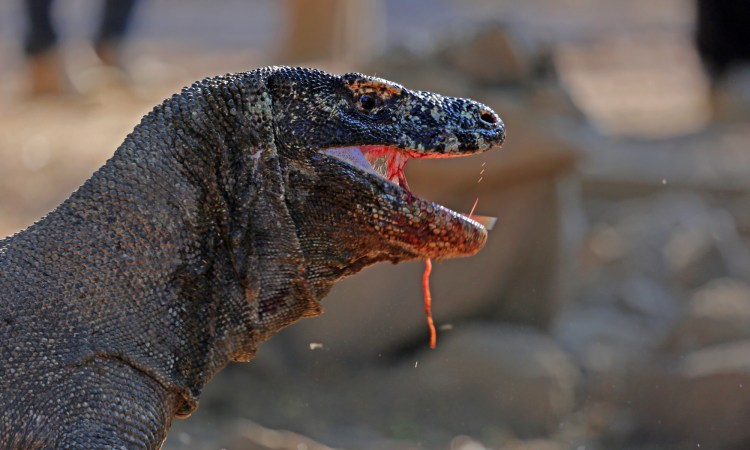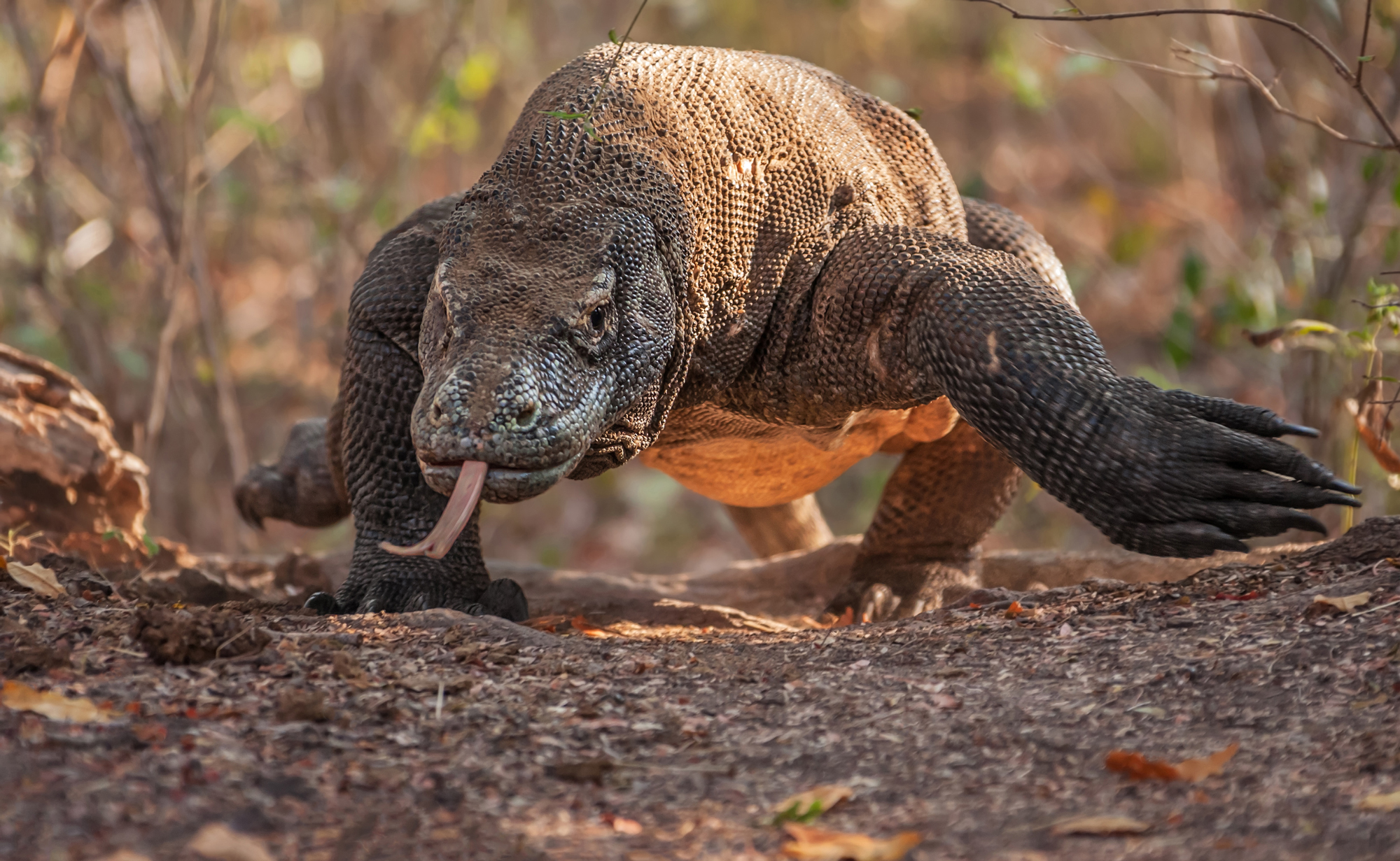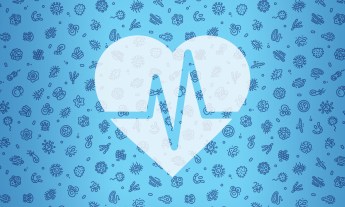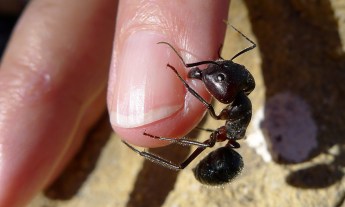
Bacterial infections that are resistant to treatment by our existing antibiotics are a huge threat to human health — and an enormous challenge for medicine. Scientists are exploring one fascinating line of research: compounds modeled after those found in the blood of the fearsome Komodo dragon.
Although they can’t breathe fire, Komodo dragons are as close as it gets to the stuff of legend. Reaching up to 366 pounds (166 kilograms) and 10 feet (3 meters) in length, they are the largest, heaviest lizards in the world; they’re extremely rare, with approximately 5,700 left in the wild; and their natural habitat consists of five Indonesian islands. And, of course, they’re lethal predators equipped with serrated teeth and toxic venom capable of killing a human within hours.
Adding to their legendary status: These fearsome beasts just might help us overcome one of the deadliest health threats we face today. Antibiotics have saved millions of lives since they were formally introduced in the 1940s. But as they’ve been used — and misused — over the years, there has been an alarming increase in resistance. In fact, rates of antibiotic-resistant infections have doubled since 2002. Extreme cases involving “nightmare bacteria” impervious to almost every available drug have become more widespread, and it’s estimated that such drug-resistant infections could potentially take 10 million lives a year by 2050, potentially outpacing cancer as a major cause of mortality.
When it comes to fighting antibiotic resistance, one vital question inspiring some researchers is: “How does nature already solve this problem?” In 2013, Barney Bishop, professor of biochemistry at George Mason University in Virginia, and collaborator Monique van Hoek began looking at large reptiles such as the American alligator and the Komodo dragon (watch van Hoek’s TEDxGeorgeMasonU Talk: Healed by a crocodile: the search for new antibiotics). Alligators “have a long reputation for being able to survive injuries in the wild, including loss of limb … with very low incidence of infection,” says Bishop. “Their wound management must be phenomenal.”
Meanwhile, Komodo dragons must be doing something right, too. They feast on decaying carcasses, host pathogenic bacteria in their mouths, and fight each other while their gums are bleeding, yet they seem to be largely unharmed by bacterial infections, with many living 30 years or more. So, what are the mechanisms that allow these animals to stay healthy?
While we humans rely more on adaptive, or acquired immunity — in which our bodies identify, eliminate and “remember” pathogens we’ve been exposed to in the past, targeting and fighting them with antibodies (what we tap into when we get vaccinated) — “reptiles tend to depend more on innate immunity to fight against infection,” says Bishop. Innate immunity protects a body against pathogens it hasn’t had previous exposure to, and it’s accomplished, in part, with small proteins called antimicrobial peptides (AMPs).
In their search for promising new antibiotics, Bishop and van Hoek are working to identify AMPs in Komodo dragons — specifically, AMPs with therapeutic utility. So, what exactly are antimicrobial peptides? To start, “a peptide is like a small protein, and antimicrobial peptides are produced by almost any living organism on the planet as part of the defense against infection,” says Bishop. “There’s evidence that many of these peptides serve in a variety of capacities — not just antimicrobial but actually stimulating the host’s immune system into action or promoting healing.”

Since Komodo dragons rely heavily on innate immunity, they’re like living databases of AMPs honed over millions of years of evolution. If we can understand their continued success in this evolutionary arms race, perhaps we could benefit. But in order to identify AMPs that could be viable for humans, each must be isolated and exhaustively tested. Circulating immune cells that express AMPs can be found in the blood, so Bishop and his colleagues have been studying blood samples collected from a male Komodo dragon named Tujah, who lives at the St. Augustine Alligator Farm in Florida.
Bishop and van Hoek began their research by considering peptides that share characteristics with known AMPs. Bishop says, “They tend to be small, they tend to be positively charged, and they tend to be what’s called ‘amphipathic,’” meaning they contain both portions that are attracted to and repelled by water. The team then uses AI to narrow down the search to the most promising peptides — web-based algorithms are effective at “predicting whether peptides are likely to be antimicrobial,” says Bishop. Based on all of this information, the team decides which peptides to move forward with. The chosen peptides are then chemically synthesized and go through a testing process.
In initial rounds of testing, peptides are evaluated by how effectively they can kill a variety of bacterial strains. If a peptide emerges successfully from these tests, it graduates from in vitro experiments (which take place in a controlled laboratory environment such as in petri dishes) to in vivo tests (which are performed in living organisms). At this point, the AMP candidates are first evaluated in waxworms, the caterpillars of the greater wax moth. Waxworms have similar immune responses to vertebrates, which makes them a good first step as the team is attempting to approximate how these peptides would behave in a human body. Next, the would-be AMP is evaluated in mice, and, finally, it moves on to wound and infection trials.
Through this process, the team has synthesized and evaluated more than 100 potential AMPs. “We’ve identified multiple peptides that show broad spectrum antimicrobial activity,” explains Bishop, meaning that “they’re effective against multiple strains of bacteria, including antimicrobial-resistant strains. We actually have a few peptides that look really exciting.” The research team has honed in on a few each from the Komodo dragon and the American alligator (in studies, one gator AMP has exhibited the ability to treat a rare respiratory infection in mice).
Each of these AMPs shows its own interesting activity. “Most appear to hit the bacterial membrane at some level,” Bishop explains. However, how they finally defeat their microbial opponents can vary: “Some peptides appear to bind to DNA; some can inhibit the ribosome; some interfere with specific protein functions; and some punch holes in membranes or cause depolarization, which can kill a cell.” Others “may stimulate the host” to defend itself, he says. Or, they may do all of the above.
Interestingly, a few of these all-star AMPs “are actually more active against the multi-drug resistant strains or antimicrobial-resistant strains of bacteria than they are against the non-resistant strains,” says Bishop. And that could be good news in the context of the antibiotic resistance crisis.
Of the AMPs that succeeded in passing the team’s rigorous tests, one Komodo peptide has Bishop feeling particularly encouraged. DRGN-1, a synthetically modified version of a peptide found in Komodo dragon blood “is very encouraging and very promising,” he says. It shows potential “as a topical treatment for wounds” that could be delivered via an ointment or spray (versus an injection).
“Based on what’s out there now, [DRGN-1] does seem to be something special,” Bishop says. He points to its antimicrobial capacities and host-directed wound-healing properties as well as its ability to disrupt biofilms, the stubborn matrices that bacterial colonies use to protect themselves and form strongholds. In his lab’s experiments with DRGN-1, the AMP was able to accelerate the rate of healing and infection clearance in mice with experimentally infected wounds faster than a human peptide (called LL-37) that is known to possess these abilities. Bishop’s lab is currently in the process of testing and refining DRGN-1, with the goal of developing it into a drug that could treat wounds and infections, including resistant strains.
“It’s a nifty little peptide. It’s taught me a lot, actually,” Bishop says, and adds, “Who would have thought that a peptide from a Komodo dragon would be able to stimulate human cells in culture to essentially stimulate wound closure?”
But what if DRGN-1 can only be used in humans until a group of bacteria becomes resistant to it, too? “We’ll probably always have to be on the lookout for new drugs and new strategies,” says Bishop. “As far as developing resistance, it can happen but we haven’t seen the same widespread resistance to AMPs occur in nature as you do with antibiotics, despite the fact that [they] have been used for hundreds of millions of years.”
Thankfully, other labs are also exploring nature-derived solutions — by looking at different kinds of deadly creatures. Lauren Esposito, the chair of arachnology at the California Academy of Sciences, is focusing on the scorpion.“So far, we’ve been able to document and describe about 1,000 bioactive compounds from scorpions all over the world,” she says (Watch her TEDxSanFrancisco Talk: Saving human kind, one scorpion at a time.) “However, we estimate that there [are] 100,000 bioactive compounds present in the scorpions living on earth right now.”
Scientists have explored only 1 percent of these molecules — the remaining 99 percent could contain game-changing solutions. In fact, 1 of the 1,000 known compounds is already showing potential: Research found that a synthetically modified version of an AMP from the venom of the Chinese scorpion was able to effectively fight MRSA infections in mice.
Similarly, Michel Dugon, professor of Zoology at the National University of Ireland, Galway, sees immense potential in venomous spiders. (Watch his TEDxGalway Talk: The secrets of spider venom.) “Spiders alone are actually thought to produce over 10 million different kinds of compounds with potential therapeutic applications,” he says. His lab is currently investigating a small species of spider that “happens to produce amazingly powerful antimicrobial compounds,” he explains. “It is even capable of killing those drug-resistant bacteria that are often giving us so much trouble.”
Someday, drugs containing all of these compounds may indeed be available at our pharmacies and hospitals, but a great deal of time, investment and research is needed before this happens. However, in the meantime, this ongoing research into bioinspired AMPs can provide new hope — for us and for future generations. “I’ve got an 8-year-old daughter,” says Bishop, “and I want her to grow up in a world where there are antibiotics.”
Watch his TEDxUbud Talk now:












